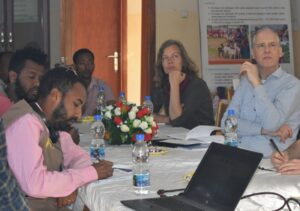Ethiopia continues to suffer the strain of climate change through drought and flooding while experiencing ongoing violent conflict in certain parts of the country. This prolonged crisis has affected over 23,81 million in terms of malnutrition, displacement, and destruction of property and livelihood. In 2022 a protracted joint response was launched to deal with the more long-term challenges Ethiopia is facing. The chair of the Dutch Relief Alliance Arjen Joosse visited Ethiopia in March to gain insight into the country’s humanitarian situation.
Joosse went to two differently affected areas: the Oromia Region being heavily affected by drought and the Amhara Region affected by conflict. He met with five partners in Ethiopia to discuss the progress of the joint response and the challenges that remain present. Joosse: “Partners are doing great work in the joint response. Overall, we are impressed with the resilience of the people and communities, and with the advantage of flexible funding and long-term humanitarian programming with resilience and anticipatory action, I believe this makes a huge difference in the lives of people in need.”
Oromia Region and the effects of drought:
In the Oromia Region, they were informed on the situation in the Fedis woreda (district), which has, over the last five years, seen its dire situation escalate. In Fedis, 70% of the population depends on agriculture and the other 30% depends on livestock. Yet as the chairman of one of the villages notes, “the harvest was 100% lost last year”, because of insufficient and erratic rainfall.
Most livestock have died because of lack in drinking water and green pastures. This has caused widespread migration, especially by men and boys who leave with their cattle, hoping to find better pastures for them. In some cases, the animals are so weak they must carry them to greener pastures. The Dutch Relief Alliance Ethiopian Joint Response has addressed these issues by arranging Multi-Purpose Cash so people can buy food, water, and tools. People also received livestock to recover some of their losses and hygiene and sanitation products to contain the spread of illness. One inhabitant, Shame Mohamed, notes how this assistance has been crucial for her and her 9 children: “I live without a husband, and no longer had any cattle, but received 3 goats from SOS Children Village Ethiopia, and cash from Action for the Needy Ethiopia, so I can feed my children”. The partners in the joint response welcomed this multi-sectoral approach but “there remains many opportunities for capacity building”.

Despite these results, challenges remain. As groundwater tables are decreasing, more long-term solutions are needed. Additionally, malnutrition no longer only affects children under five but also older children and adults, demonstrating further challenges for the region. Geke Kieft, the Ethiopian joint response country coordinator, stated that these challenges will be addressed this year through “capacity strengthening activities” which will be “designed in close collaboration with all involved stakeholders and will always be needs-based”.
Ongoing violent conflict in the Amhara Region:
Due to ethnic conflict and political issues, successfully implementing humanitarian assistance has become problematic in Ethiopia. In the Weldiya woreda (district) of the Amhara Region, because of the conflict, schools, hospitals, and water resources are damaged. People have been robbed and suffer from psycho-social trauma. Through the joint response, partners have been distributing Multi-purpose Cash, food, water and protection services. The Multi-purpose Cash has successfully gotten women back on their feet as they used the money to set up a small business that the conflict had previously destroyed.
Shop keeper Etsegenet states how a fund helped her restart her business that had been violently looted “I could restock my shop and bought the traditional dresses ‘sheetis’ to add to my inventory.”
Nevertheless, despite this progress, much work is left to be done regarding mental health services for people to deal with the trauma onset by conflict. The Vice Mayor, Dr. Dawit, emphasized that getting sustainable solutions concerning pyscho-social support was one of their main priorities as it would assist those dealing with the trauma of the conflict.
The Ethiopian Protracted joint response has provided lifesaving support and has done so through a multi-sectoral approach because the crisis is complex needing both short-term and long-term solutions. The partners have worked together to supply diverse types of assistance to the people. Nevertheless, more sustainable solutions are needed because Ethiopia has been experiencing a long-term crisis. For the Ethiopian joint response, it remains a challenge to combine humanitarian aid with the Core Humanitarian Standard. Kieft: “Due to sudden changes often happening in the country, we sometimes struggle maintaining this standard, but it remains our goal.” Joosse: “It is not likely that the situation for people in need will improve soon without longer term solutions due to the combination of conflict and drought, so continued and more humanitarian assistance is urgently required.”

Arjen Joosse and Geke Kieft during a presentation by one of the partners
Save the Children
Laan van Nieuw Oost-Indië 131-k
2593 BM Den Haag
The Netherlands
Chair organisation: Plan International
E: office@dutchrelief.org